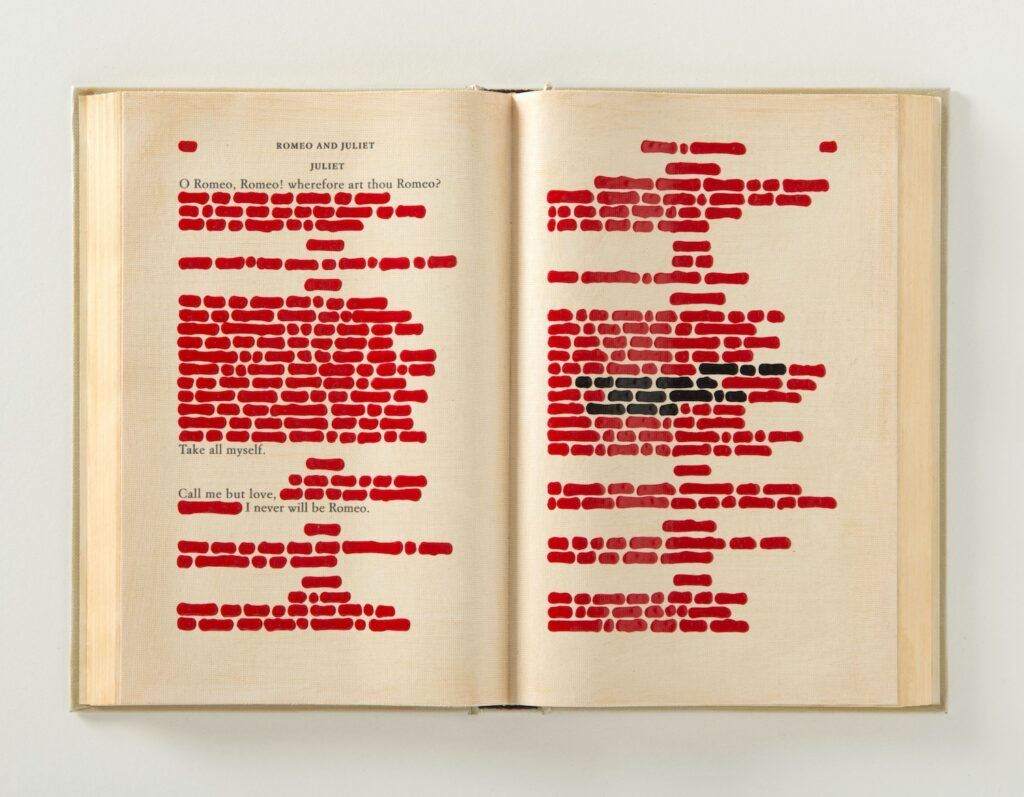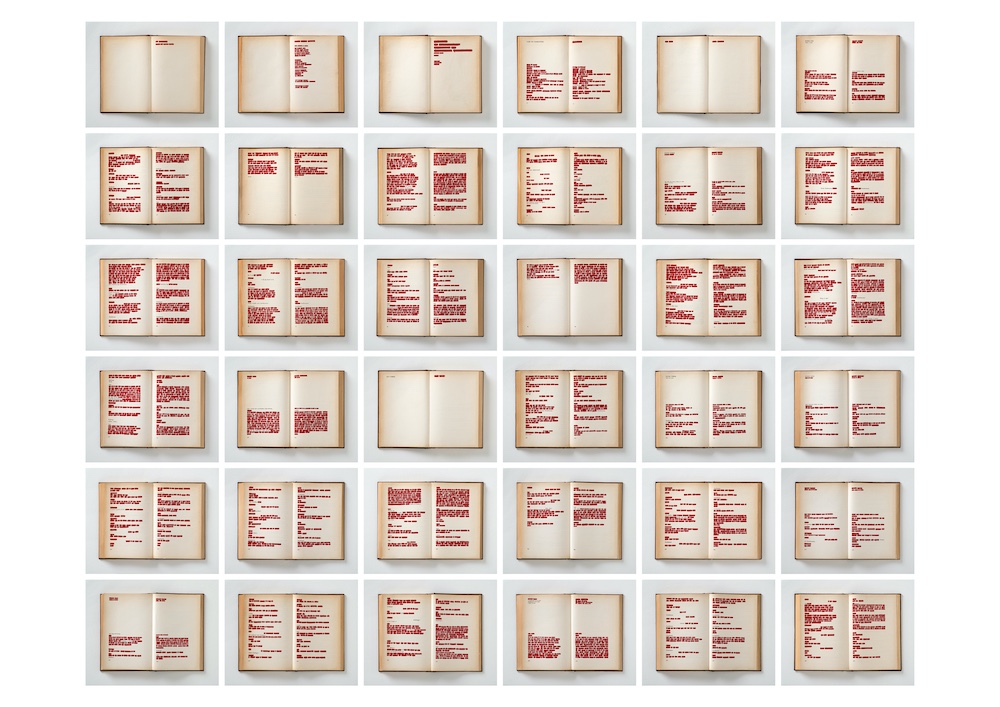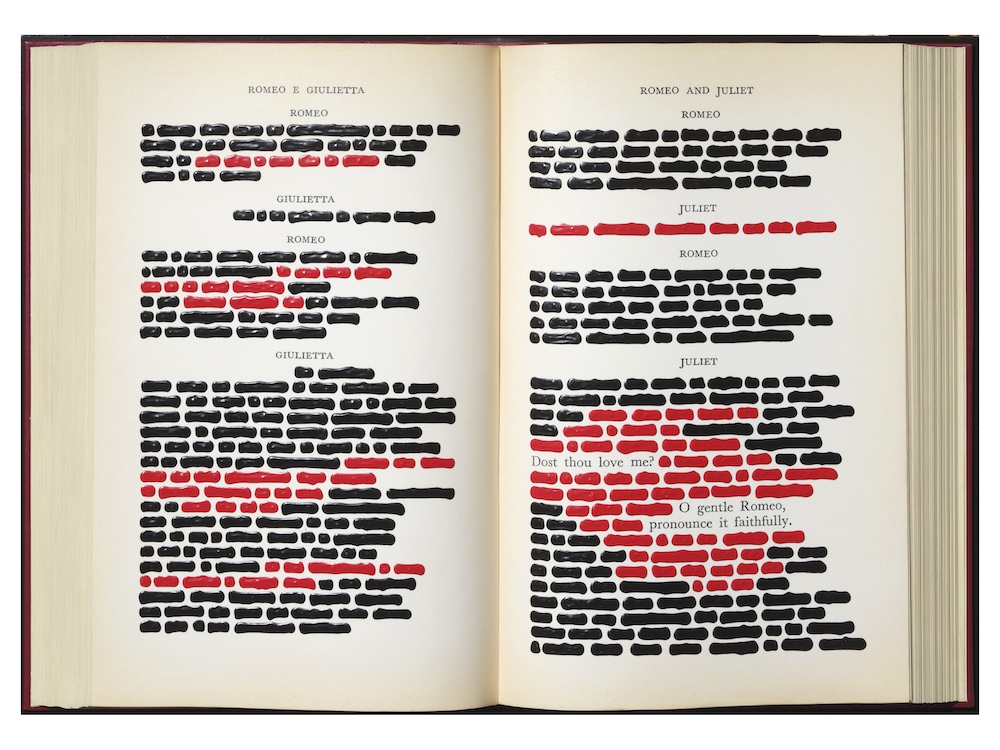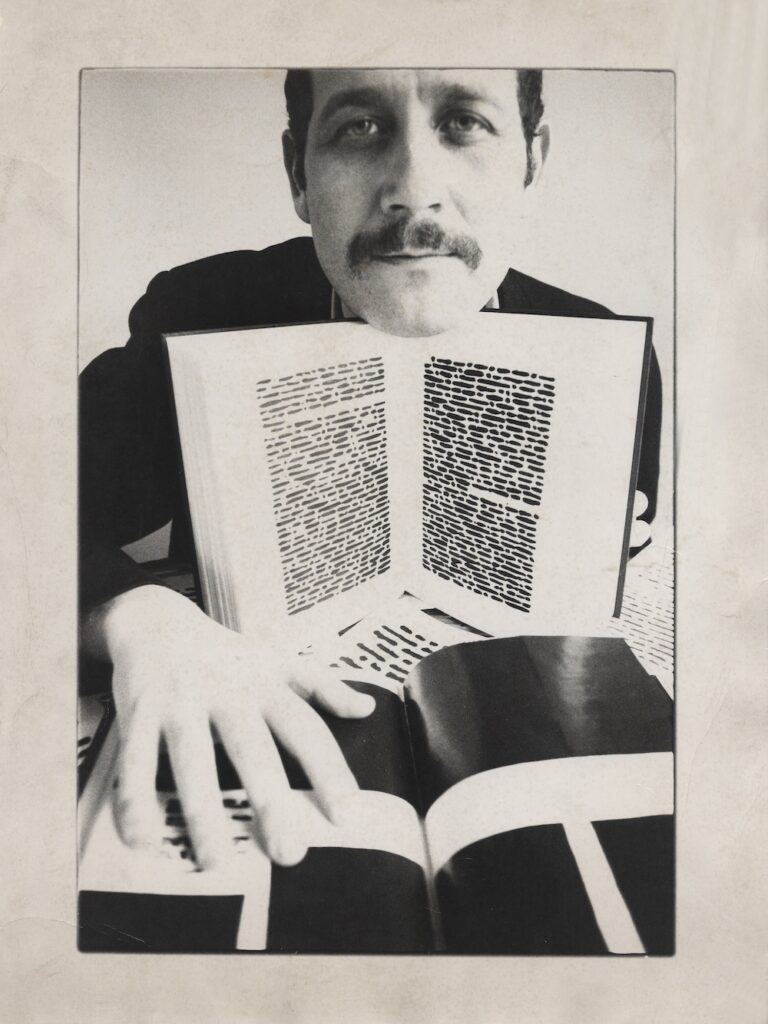When Erasure Becomes Illumination
5 November 2025 – 14 February 2026 | Tornabuoni Art Rome
Few artists have turned silence into expression as powerfully as Emilio Isgrò. With Rosso Shakespeare, now on view at Tornabuoni Arte Rome, the Sicilian-born artist redefines erasure—not as disappearance but as revelation. The exhibition traces his lifelong dialogue between word and image, between literature and art, and ultimately between what is hidden and what endures.
The Poetry of Deletion

18,89 x 26,57 x 2,16 in – 48 x 67,5 x 5,5 cm
reverse: signed, titled, dated and numbered Emilio Isgrò / Romeo and
Juliet, Going / 2019 / K 105. | Courtesy photo Tornabuoni Art
Before he became one of Italy’s most influential conceptual artists, Isgrò was a poet. His first collection, Fiere del Sud (1956), caught the attention of Pier Paolo Pasolini and later led to a friendship with Eugenio Montale. That literary foundation became the seed for his groundbreaking practice of Cancellatura (erasure), first conceived while editing articles for Il Gazzettino in Venice.
What began as the removal of “superfluous” words evolved into one of postwar Italy’s most distinctive visual languages. For Isgrò, crossing out text never meant negation. His meticulous ink blots and red marks elevate the act of deletion into a poetic gesture—a way of rebuilding communication through absence. In his words, writers must erase no less than painters.
Words Made Visible
At Tornabuoni Arte Rome, Isgrò’s exploration of text unfolds across five decades. Early works from the 1970s appear beside recent red Cancellature devoted to Shakespearean tragedy. The exhibition moves from Vitale (1972) and Odysséus (2018) to Ala italiana (2013), based on the Corriere della Sera, before culminating in monumental tributes to Romeo and Juliet (2022) and Othello (2019).
Here, the printed page becomes a stage. Stories are no longer read but seen, their meanings revealed through rhythm and color. Isgrò’s use of red—once considered impure by strict conceptualists—infuses these works with vitality. It is a color that mirrors Shakespeare’s themes of passion and conflict, while reflecting the artist’s belief that erasure can also create.
Beyond the Page
Over six decades, Isgrò has erased encyclopedias, maps, and even film. The artist’s visual language has expanded far beyond the printed page. His work has been exhibited at the Venice Biennale, MoMA in New York, Palazzo Reale in Milan, and the Fondazione Giorgio Cini in Venice.
A recent public commission for the Quirinal Palace in Rome transformed the erasure of Italy’s 1938 racial laws into an act of remembrance and renewal. Across every medium, Isgrò’s purpose remains constant: to strip away noise so essential meaning may surface.



Tornabuoni Arte: A Legacy of Vision
Founded in 1981 in Florence by Roberto Casamonti, Tornabuoni Arte has become a leading gallery for postwar and contemporary art. The gallery remains family-run and is now led by the third generation, continuing its founding passion for collecting and curation.
Tornabuoni Arte operates locations in Florence, Milan, Forte dei Marmi, Rome, Paris, Crans Montana, and London. Its curatorial program highlights both Italian avant-gardes—Fontana, Boetti, Burri, Castellani—and international masters including Picasso, Warhol, and Miró.
Annual exhibitions and museum collaborations reinforce the gallery’s reputation for excellence. Tornabuoni bridges Italy’s modern legacy with the global art scene through a refined, scholarly approach.
The gallery participates in major international fairs such as TEFAF, Frieze Masters, Arte Fiera, and Art Basel in Basel, Miami Beach, Paris, and Hong Kong. Through these platforms, Tornabuoni connects collectors and institutions, fostering a deeper understanding of Italian art’s influence worldwide.
The Word, Renewed
“For this reason I have never betrayed literature: I partly transferred
Emilio Isgrò, A. Kerbaker, Le parole di Emilio Isgrò, 2021
the demands I had encountered in the literary world into the new
world I was set to explore: visual arts and, above all, erasure, which it
is not clear whether it belongs to visual art or literary art, since writers
must erase no less than painters.”
In Rosso Shakespeare, Isgrò shows that the word—far from dead—remains the most vital pigment of all. Through deletion, he finds life. Through silence, he makes language visible once again.
Tornabuoni Arte Rome
Via Bocca di Leone 88, 00187 Rome
5 November 2025 – 14 February 2026
www.tornabuoniarte.it | @tornabuoniart
Images 2-4 Captions
Othello, 2019
acrylic on paper mounted on book and wood panel, 36 elements
10,62 x 13,38 in – 27 x 34 cm
certificate of authenticity by Archivio Emilio Isgrò, Milan, dated 13 May
2021, archive no. 0148, historical archive no. F247.
Romeo and Juliet, Gentle, 2019
acrylic on fabric paper mounted on book and wood panel
18,89 x 26,57 x 2,16 in – 48 x 67,5 x 5,5 cm
reverse: signed, titled, dated and numbered Emilio Isgrò / Romeo and
Juliet, Gentle / 2019 / K 106
Emilio Isgrò
All images courtesy of Tornabuoni Arte ©


